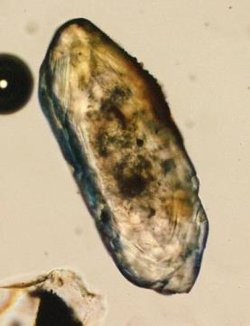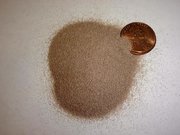Zircon
|
|
- For the spy satellite of this codename see Zircon (satellite).
| Zircon | |
|---|---|
| General | |
| Category | Mineral |
| Formula | zirconium silicate ZrSiO4 |
| Identification | |
| Color | brown, red, yellow, green, blue, black, and colorless. |
| Habit | dipyramidal prismatic |
| System | Tetragonal; 4/m 2/m 2/m |
| Cleavage | indistinct, two directions |
| Fracture | Subconchoidal to uneven - brittle |
| Hardness | 7.5 |
| Lustre | Adamantine |
| RI | nω=1.967 - 2.015 nε=1.920 - 1.960 (birefringence δ=0.047 - 0.055) |
| Streak | White |
| SG | 4.6–4.7 |
| Fusibility | Infusible |
| Solubility | Insoluble |
| Other | Fluorescent and radioactive |
Zircon is a mineral belonging to the group of nesosilicates. Its chemical formula is ZrSiO4. Hafnium is almost always present ranging from 1 to 4%. The crystal structure of zircon is tetragonal crystal class. The natural color of zircon varies between colorless, yellow-golden, red, brown or green. Colorless specimens that show gem quality are a popular substitute for diamond; these specimens are also known as "Matura diamond" (but note that cubic zirconia is a completely different synthetic mineral with a different chemical composition).
Zircon is a remarkable mineral, if only for its almost ubiquitous presence in the crust of Earth. It is found in igneous rocks (as primary crystallization products), in metamorphic rocks (as recrystallized grains) and in sedimentary rocks (as detrital grains). Large zircon crystals are seldom abundant. Their average size, e.g. in granite rocks, is about 100-300 µm, but they can also grow to sizes of several centimeters, especially in pegmatites.
The pervasive occurrence of zircon has become more important since the discovery of radiometric dating. Zircons contain amounts of uranium and thorium (from 10 ppm up to 5 wt%) and can be dated using modern analytical techniques. Since zircons have the capability to survive geologic processes like erosion, transport, even high-grade metamorphism, they are used as protolith indicators. The oldest minerals found so far are zircons from the Narryer Gneiss Terrane, Yilgarn Craton, Western Australia, with an age of 4.404 billion years. This age is interpreted to be the age of crystallization. These zircons are not only the oldest minerals on earth, they also show another interesting feature. Their oxygen isotopic composition has been interpreted to indicate that more than 4.4 billion years ago there was already water on the surface of the Earth. This is a spectacular interpretation that has been published in top scientific journals but is widely disputed. It is most likely that the oxygen isotopes, and other compositional features (the rare earth elements), simply record hydrothermal alteration. The timing of the alteration is uncertain, but this negates the necessity for ancient liquid-water oceans.
Owing to their uranium and thorium content, some zircons may undergo metamictization. This partially disrupts the crystal structure and explains the highly variable properties of zircon.
Commercially, zircons are mined for the metal zirconium which is used for abrasive and insolating purposes. It is the source of zirconium oxide , one of the most refractory materials known. Crucibles of ZrO are used to fuse platinum at tempuratures in excess of 1755 oC. Zirconium metal is used in nuclear reactors due to its neutron absorption properties. Large specimens are appreciated as gemstones, owing to their high refractive index (zicon has a refraction of around 1.95, diamond of around 2.4). The color of zircons that do not have gem quality can be changed by heat treatment. Depending on the amount of heat applied, colorless, blue and golden-yellow zircons can be made.
The name derives from the Arabic word zarqun, meaning vermilion, or perhaps from the Persian zargun, meaning golden-colored. These words are corrupted into "jargoon", a term applied to light-colored zircons. Yellow zircon is called hyacinth, from a word of East Indian origin; in the Middle Ages all yellow stones of East Indian origin were called hyacinth, but today this term is restricted to the yellow zircons.
Zirconcrystal-model.png
Zircon is a common accesory mineral and found worldwide. Noted occurrences include: in the Ural Mountains; Trentino, Monte Somma; and Vesuvius, Italy; Arendal, Norway; Sri Lanka, India; Thailand; at the Kimberley mines, Republic of South Africa; Madagascar; and in Canada in Renfrew County, Ontario, and Grenville, Quebec. In the United States: Litchfield, Maine; Chesterfield, Massachusetts; in Essex, Orange, and St. Lawrence Counties, New York; Henderson County, North Carolina; the Pikes Peak district of Colorado; and Llano County, Texas.
Thorite ThSiO4 is an isostructural related mineral.
See also
Further Reading
- The most comprehensive and up-to-date work on zircon and its related disciplines is the Mineralogical Society of America monograph published in late 2003: Hanchar & Hoskin (2003). Zircon. Reviews in Mineralogy and Geochemistry, volume 53, 500 pages. http://www.minsocam.org/MSA/RIM/Rim53.html
- D. J. Cherniak and E. B. Watson (2000): Pb diffusion in zircon. Chemical Geology 172, pp. 5-24.
- A. N. Halliday (1999): In the beginning... . Nature 409, pp. 144-145.
- Hermann Köhler (1970): Die Änderung der Zirkonmorphologie mit dem Differentiationsgrad eines Granits. Neues Jahrbuch Mineralogische Monatshefte 9, pp. 405 - 420.
- K. Mezger and E. J. Krogstad (1997): Interpretation of discordant U-Pb zircon ages: An evaluation. Journal of metamorphic Geology 15, pp. 127-140.
- J. P. Pupin (1980): Zircon and Granite petrology. Contributions to Mineralogie and Petrololgy 73, pp. 207-220.
- Gunnar Ries (2001): Zirkon als akzessorisches Mineral. Aufschluss 52, pp. 381-383.
- P. Tondar (1991): Zirkonmorphologie als Charakteristikum eines Gesteins. Dissertation an der Ludwig-Maximilians-Universität München, 87 pp.
- G. Vavra (1990): On the kinematics of zircon growth and its petrogenetic significance: a cathodoluminescence study. Contrib. Mineral. Petrol. 106, pp. 90-99.
- G. Vavra (1994): Systematics of internal zircon morphology in major Variscan granitoid types. Contrib. Mineral. Petrol. 117, pp. 331-344.
- Template:Journal reference Template:Doi Template:Web reference
References
- Hurlbut, Cornelius S.; Klein, Cornelis, 1985, Manual of Mineralogy, 20th ed., ISBN 0471805807
- Geochemistry of old zircons (http://www.geology.wisc.edu/zircon/zircon_home.html)
- Mineral galleries (http://mineral.galleries.com/minerals/silicate/zircon/zircon.htm)
- Webmineral (http://webmineral.com/data/Zircon.shtml)
- Mindat (http://www.mindat.org/min-4421.html)de:Zirkon


